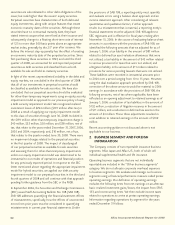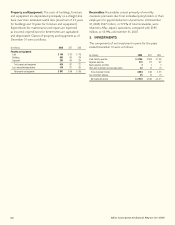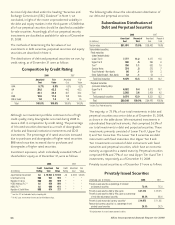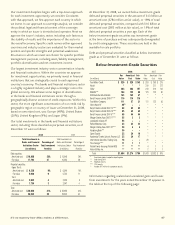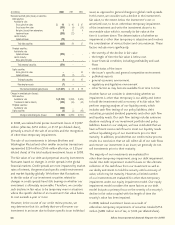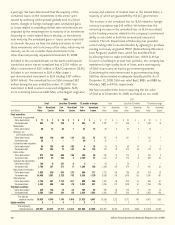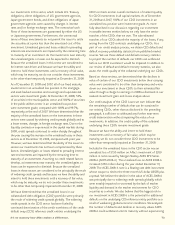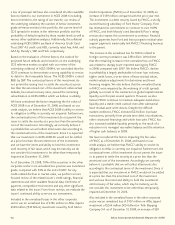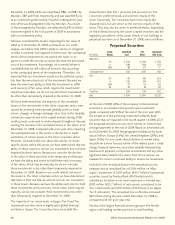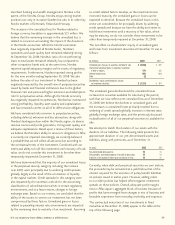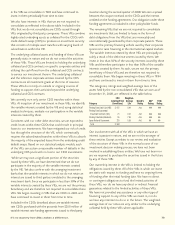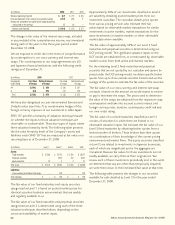Aflac 2008 Annual Report Download - page 76
Download and view the complete annual report
Please find page 76 of the 2008 Aflac annual report below. You can navigate through the pages in the report by either clicking on the pages listed below, or by using the keyword search tool below to find specific information within the annual report.
72 Aflac Incorporated Annual Report for 2008
our investment in BES would not be settled at a price less than
the amortized cost of the investment and we have the intent
and ability to hold this investment until recovery of fair value,
which may be maturity, we do not consider this investment to
be other-than-temporarily impaired at December 31, 2008.
Another component of the unrealized losses in the banks and
financial institutions sector as of December 31, 2008, was an
unrealized loss totaling $153 million related to Aflac’s $558
million investment in UniCredit S.p.A.’s German subsidiary
Bayerische Hypo-und Vereinsbank AG (HVB). Aflac’s HVB
investments include both yen-and dollar-denominated Tier
I and Tier II hybrid instruments that are subordinated fixed
maturity securities. The yen-denominated portion of these
subordinated fixed maturity securities totaled $494 million (¥45
billion) with an unrealized loss of $119 million while the dollar-
denominated portion of these securities totaled $53 million
with an unrealized loss of $38 million at year end. The increase
in the unrealized loss on our investment in HVB totaled $124
million during 2008. UniCredit, the parent company of HVB
is a financial services holding company based in Italy where it
enjoys a strong franchise with a significant presence in Germany,
Austria, Poland and Central Eastern Europe. HVB is a key part
of UniCredit with well-positioned retail and corporate banking
franchises in the South and North of Germany. HVB also houses
the Markets and Investment Banking Division of UniCredit.
The portion of the unrealized losses on our investment in HVB
related to foreign currency translation was $24 million. We
believe that the fair value of our investment in HVB is negatively
impacted by the downturn in the economic environment in
the European economies, particularly Germany, HVB’s key
market. Also negatively impacting HVB’s fair value is its parent
company’s marginal capital levels in 2008. In contrast however,
HVB reported much stronger capital levels than its parent
company at the end of September 30, 2008. Additionally,
during 2008 HVB has improved the quality of its loan portfolio
by reducing its exposure to real estate. Although HVB incurred
fairly significant asset write-downs related to structured credit
losses in 2008, its strong capital levels allowed HVB to absorb
these losses without any rating downgrades. As of December
31, 2008, all of our investments in our HVB investments carried
ratings in the A categories by Moody’s, S&P and Fitch.
As a class of securities, hybrid securities, and particularly
perpetual securities, have also suffered price erosion in the
fourth quarter of 2008 due to the financial crisis and perceived
higher deferral and extension risk. We have considered risks
common to perpetual securities, including deferral, extension
and loss absorption, in light of HVB’s strong competitive
position within the UniCredit franchise, HVB’s well-positioned
retail and corporate banking franchises in the South and North
of Germany, and HVB’s high capital ratios.
Based on our credit analysis, we believe that HVB’s ability
to service its obligation to Aflac is currently not impaired.
Accordingly, we believe it is probable that we will collect
all amounts due according to the contractual terms of the
investment. Since it is expected that our investment would
not be settled at a price less than the amortized cost of
the investment and we have the intent and ability to hold
this investment until recovery of fair value, which may be
maturity, we do not consider this investment to be other-than-
temporarily impaired at December 31, 2008.
The following table shows the composition of our investments
in an unrealized loss position in the banks and financial
institutions sectors by fixed maturity securities and perpetual
securities. The table reflects those securities in that sector that
are in an unrealized loss position as a percentage of our total
investment portfolio in an unrealized loss position and their
respective unrealized losses as a percentage of total unrealized
losses as of December 31.
2008 2007
Percentage of Percentage of Percentage of Percentage of
Total Investments in Total Total Investments in Total
an Unrealized Loss Unrealized an Unrealized Loss Unrealized
Position Losses Position Losses
Fixed maturities 41% 40% 40% 41%
Perpetual securities:
Upper Tier II 9 8 6 3
Tier I 6 12 8 19
Total perpetual securities 15 20 14 22
Total 56% 60% 54% 63%
The valuation and pricing pressures from certain structured
investment securities throughout 2008, more notably the
banks and financial institutions sector’s exposure to the well
publicized structured investment vehicles (SIVs), coupled
with their exposure to the continued weakness in the housing
sector, in the UK, Europe and the United States, has led to
significant write-downs of asset values and capital pressure at
banks and financial institutions globally. National governments
in these regions have provided support in various forms,
ranging from guarantees on new and existing debt to
significant injections of capital. As the market continues to
deteriorate, more of these banks and financial institutions may
need various forms of government support before the current
economic downturn begins to ease. While it does not appear
to be a preferred solution, some troubled banks and financial
institutions may be nationalized. Very few nationalizations
have occurred to date, and in each instance, the governments
are standing behind the classes of investments that we own.
All of the investments in the government and guaranteed
sector in an unrealized loss position were investment grade
at December 31, 2008 and 2007. The unrealized losses on


